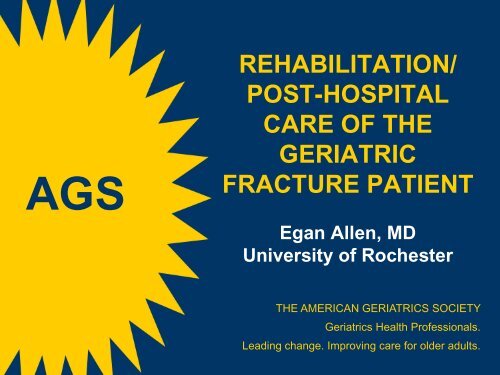rehabilitation - American Geriatrics Society
rehabilitation - American Geriatrics Society
rehabilitation - American Geriatrics Society
Create successful ePaper yourself
Turn your PDF publications into a flip-book with our unique Google optimized e-Paper software.
AGSREHABILITATION/POST-HOSPITALCARE OF THEGERIATRICFRACTURE PATIENTEgan Allen, MDUniversity of RochesterTHE AMERICAN GERIATRICS SOCIETY<strong>Geriatrics</strong> Health Professionals.Leading change. Improving care for older adults.
WHAT IS COVERED• Recovery rates post-fracture• Goals and variables• Rehabilitation across settings• Subacute (SNF) <strong>rehabilitation</strong>• Home care and falls assessment• Transitions across settingsSlide 2
MORTALITY AFTERGERIATRIC HIP FRACTURE• 7% at 1 month• 13% at 3 months• 24% at 12 months• 50% at 6 months for patients with end-stage dementia• Fracture is marker of frailty• Mortality increases with:‣ Uncontrolled systemic disease‣ Multiple comorbidities‣ DementiaLu-Yao, et al. Am J Pub Health. 1994;84:1287-1291.Morrison RS, et al. JAMA. 2000;284:47-52.Slide 3
FUNCTIONAL RECOVERY AFTERGERIATRIC HIP FRACTURE• Pre-fracture ability and post-fracture complicationsdrive recoverability• At 6 months:‣ 60% recover pre-fracture walking ability‣ 50% recover pre-facture performance of ADLs‣ 25% recover pre-facture performance of IADLs• At 12 months:‣ 54% able to walk unaided‣ 40% able to perform all ADLs independently‣ 25% require long-term SNF placementMagaziner, et al. J Gerontol. 1990;45:M101-M107.Slide 4
REHABILITATION GOALS• Regain function• Pain control• Maintain ROM and strength of unaffected limbs• Restore ROM and strength of affected limb• Clarify long-term needs and develop care plans• Communicate prognosis• Prevention of:‣ Pressure sores‣ Constipation‣ DVT‣ Pneumonia‣ DepressionSlide 5
VARIABLES AFFECTINGREHABILITATION• Pre-fracture chronic disease control‣ COPD, CAD, HTN, DM, arthritis, CHF, anemia,incontinence, vision, hearing, malignancy, nutrition• Cognitive status• Mood• Delirium• Pre-fracture ambulatory status• Weight-bearing status• Type of fracture and repairSlide 6
REHABILITATION ACROSS SETTINGS• Continual process from hospital to SNF to home/LTC• Acute vs. subacute rehab: no differences in outcomesfor geriatric fracture patients• >5 PT sessions per week likely beneficial• A systematic home-based program may be effective• No significant data supporting or refuting ongoinghome rehab s/p traditional rehab programMorrison RS, Siu AL. Medical aspects of hip fracture management. In:Cassel CK et al, ed. Geriatric Medicine: An Evidence-Based Approach.4th ed. New York, NY: Springer; 2003.Slide 7
ACUTE, IMMEDIATE POST-OP REHAB• Pain control• Stand, transfer• Walker use instruction• Early unrestricted weight-bearing accelerates hospitald/c without increasing risks of operative complications• Full weight-bearing vs. non-weight-bearing exercises:similar outcomes in strength, balance, and functionMorrison RS, Siu AL. Medical aspects of hip fracture management.In: Cassel CK et al, ed. Geriatric Medicine: An Evidence-BasedApproach. 4th ed. New York, NY: Springer; 2003.Slide 8
SUBACUTE (SNF) REHAB• Up to 100 days covered by Medicare if 3-dayhospital stay• Regional and facility variations• Interdisciplinary care usual and mandatedPTOTMedicalNursingSocial workRecreational therapyNutritionClergySlide 9
SUBACUTE (SNF) REHABPARTNERSHIP CONSIDERATIONS• Full time, on-site medical staff• Dedicated transitional care/rehab unit• Ability to manage parenteral meds, multidrug-resistantorganisms, medical comorbidities• Shared electronic data systems• Financial/institutional relationships• Weekend therapy and admission ability• LocationSlide 10
HOME CARE• Requires order from physician• Generally short and episodic care only• Frequency of visits limited• Post-rehab ongoing home therapy not proveneffective to improve function or decreaserepeat falls‣ However, may be of benefit for other reasonsSlide 11
FALLS ASSESSMENT• In-home assessment and intervention not yetproven effective‣ PROFET‣ FACT — ongoing in New Zealand• Health assessment• Home hazard identification• Bone health assessment and treatment• Structured exercise program• PQRI 2008 — Screening for Future Falls RiskSlide 12
ELEMENTS OF FALLS ASSESSMENT• Predisposing risk factors/ diseases• Balance and gait assessment‣ Single best means of identifying pts at risk:• Get Up and Go• Performance Oriented Assessment of Mobility• Review of previous fall situationsSlide 13
FALL PREVENTION• Environmental modifications‣ Lighting, rugs, toys, pets, bed/chair height, bars/rails• Endurance, resistance, flexibility and balancetraining effective (FICSIT)• Medication management‣ Orthostasis, psychoactives, anticholinergics• Vision exam and cataract removal• Talking and walkingSlide 14
TRANSITIONS IN CARE“…random events connected to highlyvariable actions with only a remotepossibility of meeting impliedexpectations.”Roger Resar, MDSenior Fellow, Institute for Healthcare ImprovementSlide 15
POOR TRANSITIONS• Duplication of tests and services• Medication errors• Increased costs• Increased readmissions• Patient/family dissatisfaction• Friction among cliniciansColeman. JAGS 2003;51:549-555.Kripalni, et al. J Hosp Med. 2007;2:314-323.Slide 16
COMPONENTS OFA SUCCESSFUL TRANSITION• Communication clinician : clinician• Communication clinician : patient/caregiver• Medication reconciliation• Patient self-care knowledgemake the next move?”• Clearly defined follow-up expectations• Mindset of continuous management“What do you need toColeman. JAGS 2003;51:549-555.Kripalni, et al. J Hosp Med. 2007;2:314-323.Slide 17
DISCHARGE SUMMARY ELEMENTS FORGERIATRIC FRACTURE PATIENTS• Baseline and current functional status• Medication reconciliation• Requirements for durable medical equipment• Advance directives• Statement of prognosis• Disposition: From To in short term To in long term• Complete and accurate summary of complications• Listing of involved clinicians and contact infoSlide 18
THANK YOU FOR YOUR TIME!Visit us at:www.americangeriatrics.orgFacebook.com/<strong>American</strong><strong>Geriatrics</strong><strong>Society</strong>Twitter.com/Amer<strong>Geriatrics</strong>linkedin.com/company/american-geriatricssocietySlide 19
















